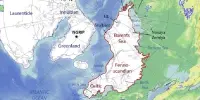An international team of scientists has advised against depending on nature to provide simple ‘early warning’ indicators of a climate calamity, citing new mathematical modeling that reveals fascinating parts of the complexity of climate dynamics. It shows that the climate system may be more unpredictable than previously believed.
By modeling the Atlantic meridional overturning circulation, one of the primary ocean current systems, the team, which includes mathematicians from the University of Leicester, discovered that the system’s stability is significantly more complex than the previously thought simple ‘on-off’ states. Switching between these states may cause significant changes in the North Atlantic region’s climate, but this pales in comparison to the tremendous repercussions of a transition between qualitatively distinct states.
However, some of these modest transitions may eventually amplify to generate a significant shift between fundamentally dissimilar states, with far-reaching global climate consequences. Early warning signs may be inadequate to identify the severity of the subsequent tipping points. Like a Jenga tower, removing some blocks may impact the system’s stability, but we don’t know which block will bring the entire system tumbling down.
Their findings have been published in Science Advances in a report authored by the Niels Bohr Institute at University of Copenhagen.
This study paves the path for examining the climate via the lenses of statistical mechanics and complexity theory. It really promotes a new perspective on climate, where you have to combine intricate numerical simulations, empirical facts, and theory in an unavoidable mixing.
Professor Valerio Lucarini
The Atlantic meridional overturning circulation is a key component of the climate system. It carries heat from low to high latitudes in the northern Atlantic, which contributes to positive thermal anomalies in northern and western Europe, as well as the North Atlantic region downstream. A slowdown in circulation would cause a relative cooling in this region.
Predicting the behavior of our climate, such as the Atlantic meridional overturning circulation, is difficult due to its enormous complexity. Scientists must either use a model with the highest feasible resolution or attempt to explain its behavior using a less resource-intensive model that allows for thorough statistical analysis.
Professor Valerio Lucarini from the University of Leicester School of Mathematical and Computer Science said: “Within each state there is a multiplicity of nearby states. Depending on where or what you are observing, you might find some indicators of nearing collapse. But it is not obvious whether this collapse will be contained to nearby states or lead to a major upheaval, because the indicators only reflect the local properties of the system.

“These states represent the various ways in which the Atlantic meridional overturning circulation organises itself on vast scales, having important implications for global climate and, particularly, regional climate in the North Atlantic. In some cases, the circulation may reach a ‘tipping point’ where the system becomes unstable and collapses. Early warning indicators suggest that the system may be transitioning to a new state, but we don’t know how different it will be.
“In a separate investigation we have seen something similar occurring in paleoclimatic records: when you change your timescale of interest – just like a magnification lens — you can discover smaller and smaller scale distinct features that are indicative of competing modes of operation of the global climate. Paleoclimatic records of the last 65 million years allowed us to provide a new interpretation of the climate evolution over that time period, and reveal these multiple competing states.
“This study paves the path for examining the climate via the lenses of statistical mechanics and complexity theory. It really promotes a new perspective on climate, where you have to combine intricate numerical simulations, empirical facts, and theory in an unavoidable mixing. You must recognize and accept its complexity. There are no shortcuts or free meals in our understanding of climate, but we are learning a lot from it.”
















